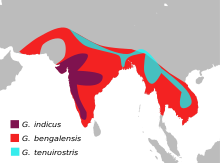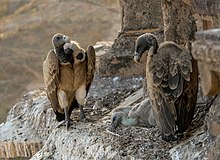Indian vulture
| Indian vulture | |
|---|---|

| |
| Indian vulture sunbathing in Mhasla, Maharashtra | |
| Scientific classification | |
| Domain: | Eukaryota |
| Kingdom: | Animalia |
| Phylum: | Chordata |
| Class: | Aves |
| Order: | Accipitriformes |
| Family: | Accipitridae |
| Genus: | Gyps |
| Species: | G. indicus
|
| Binomial name | |
| Gyps indicus | |

| |
| Distribution in purple | |
The Indian vulture (Gyps indicus) is an Old World vulture native to India, Pakistan and Nepal. It has been listed as Critically Endangered on the IUCN Red List since 2002, as the population severely declined. Indian vultures died of kidney failure caused by diclofenac poisoning.[1] It breeds mainly on hilly crags in central and peninsular India.
The slender-billed vulture Gyps tenuirostris in the northern part of its range is considered a separate species.
Description

The Indian vulture is medium-sized and bulky. Its body and covert feathers are pale, its flight feathers are darker. Its wings are broad and its tail feathers short. Its head and neck are almost bald, and its bill is rather long. It is 81–103 cm (32–41 in) long and has a wing span of 1.96–2.38 m (6.4–7.8 ft). Females are smaller than males.[3]
It weighs 5.5–6.3 kg (12–14 lb). It is smaller and less heavily built than the Eurasian griffon. It is distinguished from that species by its less buff body and wing coverts. It also lacks the whitish median covert bar shown by griffons.[4]
Behaviour and ecology

The Indian vulture breeds mainly on cliffs in South and Central India, but is known to use trees to nest in Rajasthan. It may also breed on high human-made structures, like the Chaturbhuj Temple. Like other vultures, it is a scavenger, feeding mostly from carcasses, which it finds by soaring over savannah and around human habitation. It often congregates in flocks.
Status and conservation
Population declines

The Indian vulture and the white-rumped vulture, G. bengalensis species have suffered a 99%–97% population decrease in Bangladesh, Pakistan and India. Between 2000-2007 annual decline rates of this species and the slender-billed vulture averaged over sixteen percent.[5] The cause of this has been identified as poisoning caused by the veterinary drug diclofenac. Diclofenac is a non-steroidal anti-inflammatory drug (NSAID) and when given to working animals it can reduce joint pain and so keep them working for longer. The drug is believed to be swallowed by vultures with the flesh of dead cattle who were given diclofenac in the last days of life.
Diclofenac causes kidney failure in several species of vultures. In March 2006 the Indian Government announced its support for a ban on the veterinary use of diclofenac. Another NSAID, meloxicam, has been found to be harmless to vultures and should prove to be an acceptable substitute for diclofenac. When meloxicam production is increased it is hoped that it will be as cheap as diclofenac. As of August 2011 the ban for veterinary use for approximately a year did not prevent diclofenac use across India.[6] Small numbers of birds have bred across peninsular India, in Karnataka and Tamil Nadu, especially in villages around Bangalore.[7] The decline in the Indian vulture has drastically affected the conservation of the environment. By removing all carcasses, vultures had helped decrease pollution, disease spread, and suppressed undesirable mammalian scavengers.[8] In their absence, the population of feral dogs and rats, along with their zoonotic diseases, has increased greatly.[9]
Captive-breeding programmes

Captive-breeding programmes for several species of Indian vulture have been started. The vultures are long lived and slow in breeding, so the programmes are expected to take decades. Vultures reach breeding age at about five years old. It is hoped that captive-bred birds will be released to the wild when the environment is clear of diclofenac.
In early 2014 the Saving Asia's Vultures from Extinction (Save) programme announced that it expects to start releasing captive-bred birds into the wild by 2016.[10]
Two captive Himalayan griffons were released in June, 2016 from Jatayu Conservation Breeding Centre, Pinjore as part of Asia's first vulture re-introduction program.[11]
References
- ^ a b BirdLife International (2017). "Gyps indicus". IUCN Red List of Threatened Species. 2017: e.T22729731A117875047. Retrieved 31 January 2020.
- ^ Scopoli, J. A. (1786–88). "Aves". Deliciae Flora et Fauna Insubricae Ticini. An account including new descriptions of the birds and mammals collected by Pierre Sonnerat on his voyages. London: C. J. Clay. pp. 7–18.
{{cite book}}: External link in|chapterurl=|chapterurl=ignored (|chapter-url=suggested) (help) - ^ Ferguson-Lees, J.; Christie, D. A. (2001). "Long-billed Vulture Gyps indicus". Raptors of the World. Boston, New York: Houghton Mifflin Harcourt. p. 120. ISBN 0618127623.
{{cite book}}: External link in|chapterurl=|chapterurl=ignored (|chapter-url=suggested) (help); Unknown parameter|last-author-amp=ignored (|name-list-style=suggested) (help) - ^ "The Peregrine Fund". The Peregrine Fund. 2010. Archived from the original on 2011-05-26. Retrieved 2011-05-31.
- ^ "BirdLife Fact Sheet: Indian vulture". BirdLife International. Retrieved 11 August 2014.
- ^ Jagga, Raakhi (7 August 2011). "Banned diclofenac still kills vultures". Express India. Retrieved 11 August 2014.
- ^ Oppili, P. (7 November 2013). "Long-billed Vulture sighted after 40 years". The Hindu. Retrieved 11 August 2014.
- ^ Prakash, V.; Bishwakarma, M. C.; Chaudhary, A.; Cuthbert, R.; Dave, R.; Kulkarni, M.; Kumar, S.; Paudel, K.; Ranade, S. (2012). "The Population Decline of Gyps Vultures in India and Nepal Has Slowed since Veterinary Use of Diclofenac was Banned". PLOS ONE. 7 (11): e49118. doi:10.1371/journal.pone.0049118. PMC 3492300.
{{cite journal}}: Unknown parameter|last-author-amp=ignored (|name-list-style=suggested) (help)CS1 maint: unflagged free DOI (link) - ^ Prakash, V.; Pain, D.J.; Cunningham, A.A.; Donald, P.F.; Prakash, N.; Verma, A.; Gargi, R.; Sivakumar, S.; Rahmani, A.R. (2003). "Catastrophic collapse of Indian white-backed Gyps bengalensis and long-billed Gyps indicus vulture populations". Biological Conservation. 109 (3): 381–390. doi:10.1016/S0006-3207(02)00164-7.
{{cite journal}}: Unknown parameter|last-author-amp=ignored (|name-list-style=suggested) (help) - ^ Kinver, M. (31 Jan 2014). "Project targets 2016 for Asian vultures release". BBC News. Retrieved 2 February 2014.
- ^ "Asia's first vulture re-introduction programme launched in Haryana".

